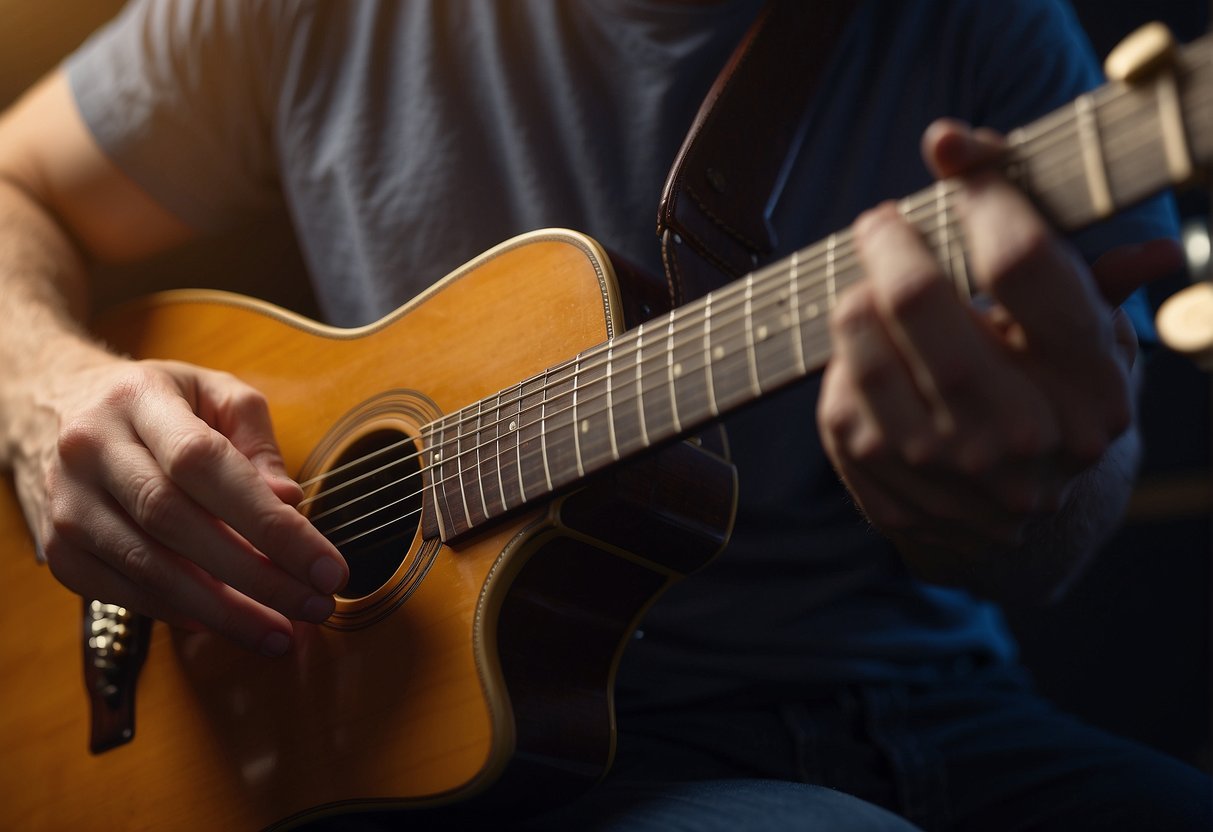D Chord Guitar Guide: Mastering the Basics in Minutes
The D major chord, often simplified to the “D chord,” is a fundamental aspect of playing the guitar. It is one of the first chords beginners learn due to its relatively easy finger positioning and pleasant, harmonic sound. The D chord utilizes three fingers on the high E, B, and G strings, producing a bright and resonant tone that is integral to many songs. Guitarists of all levels continually work to perfect the clarity and transition smoothness of this essential chord.

In exploring the D chord further, guitarists can discover various shapes and forms, including open, barre, and extended versions, each with its unique sound and application. Mastering the D chord is not
just about finger placement; it involves understanding its musical context, its role within chord progressions, and how to transition effectively to and from other chords. A clean, well-strummed D chord can elevate the harmony of a piece, making it a critical skill for performing a wide repertoire of music.Key Takeaways
- The D chord is a basic yet essential guitar chord that beginners learn early on.
- Mastery of the D chord extends beyond finger placement to include its use in various forms and progressions.
- Proficiency in playing the D chord enhances a guitarist’s ability to perform a diverse range of songs.
Understanding the D Chord
The D chord is a fundamental element in guitar playing, often noted for its bright and resonant sound. This section will focus on the technical composition of the
D chord and the diverse variations available to guitarists.Chord Structure and Theory
The D major chord consists of three specific notes: D, F♯, and A. These are the first (root), third, and fifth notes, respectively, of the D major scale. This triad creates a harmonious sound characteristic of major chords. The standard tuning of a guitar results in this chord being frequently played as an open chord, with the D and A strings ringing open, adding to the chord’s richness.
Open D Major Chord Fingering:
- D String (4th): Open
- G String (3rd): Fret 2 (F♯)
- B String (2nd): Fret 3 (D)
- E String (1st): Fret 2 (A)
Chord Variations and Voicings
Chord variations and voicings allow guitarists to play the D chord in different positions on the fretboard, offering a range of sounds suitable for various musical contexts. For example, the Dsus2 chord is a simplified alternate version that creates a more open sound by omitting the third of the chord. The versatility of the D chord can also be expanded through barre chord techniques, playing the chord higher up on the neck, which can provide a fuller, more resonant tone.
Common D Chord Variations:
- Dsus2: Omit the F♯ on the G string, leaving it open
- Dsus4: Add the G note by placing a finger on the 3rd fret of the E string
- D Major Barre Chord (Root on 5th string, 5th fret)
- D Major Barre Chord (Root on 6th string, 10th fret)
Exploring these variations empowers players to adapt the D chord to different musical styles and song arrangements, broadening their expressive capabilities on the guitar.
Playing the D Chord
The D major chord is a fundamental guitar chord, integral in many genres of music. Players achieve its bright and harmonic sound through precise finger placement and adept strumming techniques.
Finger Placement
To form the D major chord, a guitarist places their fingers on the following frets and strings:
- The index finger on the 2nd fret of the G (3rd) string.
- The middle finger on the 2nd fret of the E (1st) string.
- The ring finger on the 3rd fret of the B (2nd) string.
They should ensure their fingers are not touching any other strings to allow each note to ring clearly.
Strumming Techniques
When strumming the D major chord, guitarists typically avoid the lower E and A strings to maintain the chord’s character. They can use a simple down-up strumming pattern, making contact with the highest four strings. For more control over the sound, they might use the technique of string muting—gently touching the unwanted strings with their thumb to prevent them from sounding.
Transitioning Between Chords
Mastering the transition between chords is essential for fluid guitar playing. It enables a guitarist to shift from one chord to another seamlessly, maintaining rhythm and harmony throughout a piece.
Common Chord Progressions
Several chord progressions form the foundation of countless songs. A common transition in many popular songs is moving from the D chord to the G chord. For instance, the progression D-G-A is often used and can be heard in classics like “Sweet Home Alabama” by Lynyrd Skynyrd. Another noteworthy progression is D-A-Bm-G, which lays the groundwork for the popular hit “Wonderwall” by Oasis.
Practice Tips for Smooth Transitions
- Finger Placement: Pay close attention to the position of fingers during transitions. One should practice chord shapes separately to develop muscle memory.
- Minimal Movement: Efficiently moving fingers between chords is key. For the D to G transition, one should use the pivot finger technique, which involves keeping the ring finger on the third fret of the B string while changing chords.
- Metronome Use: Incorporating a metronome into practice can significantly improve timing and rhythm during transitions. One should start slow, gradually increasing the speed as they become more comfortable.
By focusing on these areas during practice, guitarists can significantly improve their ability to transition between chords, making their overall playing sound more polished and professional.
Improving Your D Chord
Mastering the D chord on the guitar involves developing finger strength and focusing on techniques that ensure a clean, clear sound. This section will provide specific exercises and techniques to help guitarists enhance their D chord proficiency.
Exercises for Finger Strength
- Finger Curls: Guitarists can benefit from finger curls to build dexterity. Start with fingers straight, then slowly curl them into a fist, and finally straighten them again. Repeat this sequence for a minute or two daily.
- Fretting Practice: Place the fingers on the fretboard and press down on the strings, without strumming, to build strength and muscle memory. The Dsus2 chord is a stepping stone to mastering the full D chord, as it requires fewer fingers and can be held for longer periods.
Techniques for Clean Sound
- String Muting Awareness: Ensure the thumb is positioned at the middle of the neck’s back, granting the fingers a better arch to avoid unintentional string muting. One common issue is the E string not ringing out; attention to thumb placement can alleviate this.
- Chord Transitions: Practice moving from a G major chord or A major chord to the D shape and back. This helps develop a more confident hand shape and avoids notes blending together inadvertently.
D Chord in Songs
The D major chord is frequently encountered in many genres of music and is a cornerstone in songwriting. It possesses a bright, uplifting sound that integrates seamlessly into a variety of musical landscapes.
Analyzing Song Structures
Songs often employ the D major chord to evoke a sense of brightness and clarity. In terms of harmony, it often appears in the key of D major, where it serves as the tonic, and in other keys as a part of chord progressions. For instance, a common progression like G-D-Em-C showcases how the D chord functions within a broader harmonic context, underpinning the song’s structure.
Practice with Popular Songs That Use the D Chord
A valuable practice technique involves learning songs that incorporate the D chord. Several popular songs that feature the D chord prominently could be found and learned through. For example:
- “Sweet Caroline” by Neil Diamond, where the D chord underscores the memorable chorus.
- “Brown Eyed Girl” by Van Morrison, incorporating a D chord that gives the song its characteristic jauntiness.
By practicing such songs, guitarists can improve their chord transitions and gain a deeper understanding of the D chord’s role in music.
Frequently Asked Questions
The D chord is a fundamental element of guitar playing, central to numerous songs and often one of the first chords guitarists learn. Mastering it can pose challenges, but with precise finger placement and practice, it becomes a key component of a guitarist’s repertoire.
How can I master the fingering for a D chord on guitar?
One can master the fingering for a D chord on guitar by consistent practice. Starting slowly and ensuring each string rings clearly can create muscle memory. Over time, this will allow a guitarist to form the chord quickly and accurately. Check out some techniques at Guitar Lobby.
What is the correct finger placement for playing a D major chord?
For playing a D major chord, position the index finger on the second fret of the third string, the ring finger on the third fret of the second string, and the middle finger on the second fret of the first string. The fourth string is played open. For visual guidance, Fender provides a helpful resource on how to play the D chord.
Why do beginners often struggle with the D chord on guitar?
Beginners often struggle with the D chord because it requires precise finger positioning and dexterity. It’s common to accidentally mute strings or not press down hard enough to get a clear sound. Developing the coordination necessary for this chord takes practice, as highlighted on National Guitar Academy.
How many strings should you strum when playing the D chord on a guitar?
When playing the D chord on a guitar, one should strum the bottom four strings, avoiding the fifth and sixth strings. Strumming only these strings ensures the chord sounds bright and full as intended.
Can you suggest some easy songs that include the D chord for practice?
Easy songs that include the D chord for practice are plentiful. “Brown Eyed Girl” by Van Morrison and “Wish You Were Here” by Pink Floyd incorporate the D chord and are excellent for beginners. Such songs help practice chord transitions in a musical context.
What are some effective exercises to improve D chord transitions?
Effective exercises to improve D chord transitions involve repeatedly switching between the D chord and other chords without stopping. Doing this for just a few minutes daily can greatly enhance agility and speed. Tools and exercises are available from On Point Guitar.


